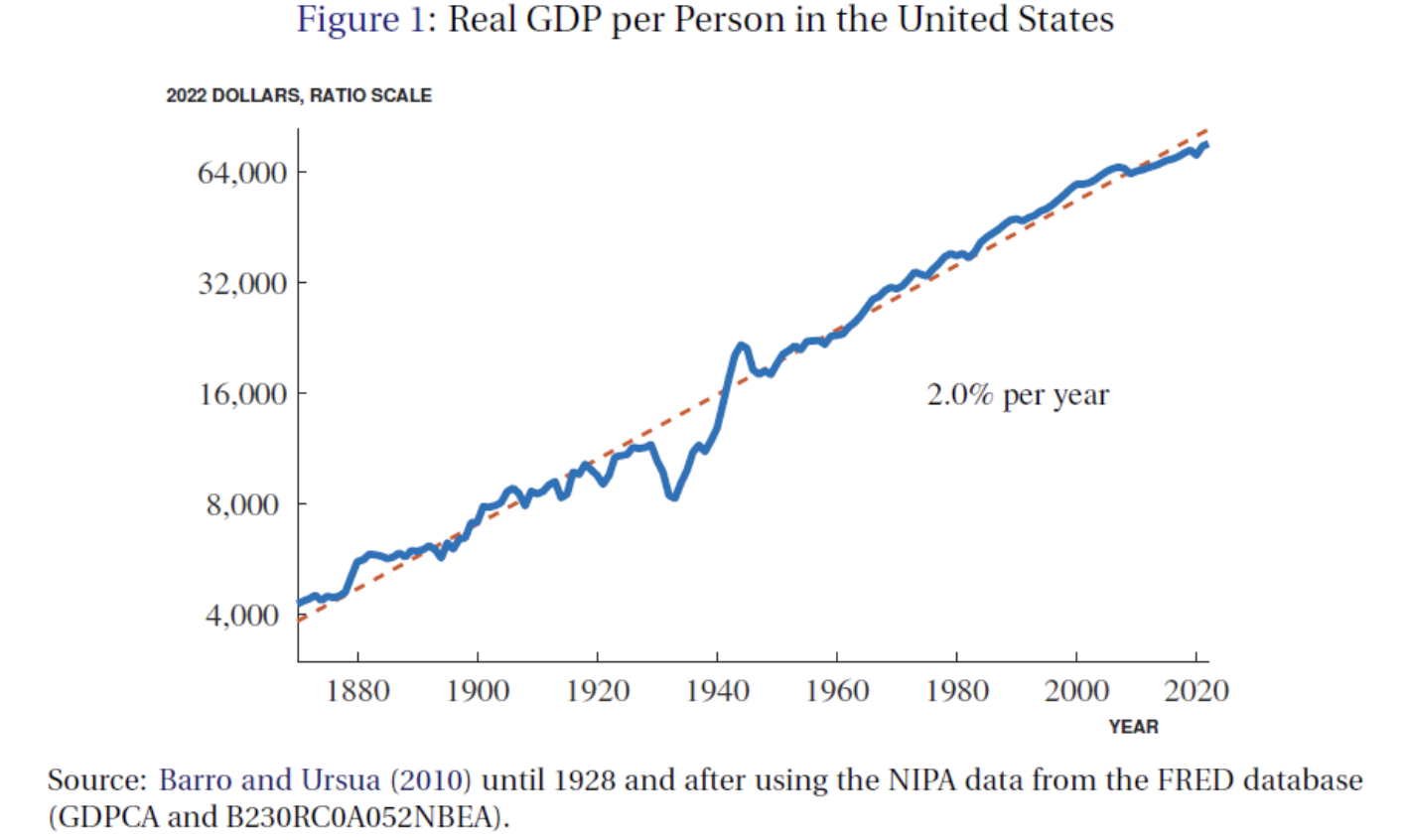Comments
- No comments found

It is remarkable but true that per capita US economic growth has hewed close to a trendline of 2% per year for the last 150 years.
Here’s a recent figure showing this pattern from Charles Jones in his paper “The Outlook for Long-Term Economic Growth,” as prepared for the annual symposium at Jackson Hole hosted by the Federal Reserve Bank of Kansas City (August 2023, full symposium proceedings including Jones’s paper available here, Jones’s paper also available as NBER Working Paper #31648).

Notice that the left-hand axis of the figure is a logarithmic (that is, a proportional) scale. On such a scale, a 2% growth rate appears as the straight dashed red line. The path of the US economy has sometimes been a little above this line, and sometimes a little below below. But the fact that the 2% annual growth rate fits the long-term pattern so well is quite remarkable. This pattern isn’t a new discovery: for example, here’s a previous post from 2012 discussing it.
Jones presents a succinct summary of possible reasons why future growth rates might rise or fall. He tends to be a pessimist about future growth rates, for two main reasons for pessimism. 1) Growth comes from new ideas that can spread freely, and more people means more possibilities that some of them will develop these new ideas, so slower population growth will result in slower technological growth. 2) Some of the forces that contributed to US growth in the past, like an overall rise in US education levels and a rise rate of investment in R&D and new ideas, seem to have stopped rising or at least slowed dramatically.
Conversely, he also offers three potential reasons for optimism. First, economic development in previously poor countries like China and India means a larger pool of people who can participate in the search for new ideas, which can then spread to the US economy. Second, the US has been experiencing improvements in the allocation of talent as members of groups that have been historically underrepresented in science and technology have been playing a growing role. Third, artificial intelligence and increased automation may together improve the growth rate.
For myself, I think I have a pretty good grasp on the US economy with about a 2-3 year lag: that is, I’m currently feeling as if I have a reasonably good grip on what happened in the US economy up through mid-2021. Coming to an understanding of the past is hard enough for me; I’m not in the business of future predictions. But for those who are predicting either a resurgence or collapse in long-term growth, I would suggest that they have some respect for the fact that a 2% annual growth trend for the US economy has persisted through some very dramatic changes in the last 150 years.
Timothy Taylor is an American economist. He is managing editor of the Journal of Economic Perspectives, a quarterly academic journal produced at Macalester College and published by the American Economic Association. Taylor received his Bachelor of Arts degree from Haverford College and a master's degree in economics from Stanford University. At Stanford, he was winner of the award for excellent teaching in a large class (more than 30 students) given by the Associated Students of Stanford University. At Minnesota, he was named a Distinguished Lecturer by the Department of Economics and voted Teacher of the Year by the master's degree students at the Hubert H. Humphrey Institute of Public Affairs. Taylor has been a guest speaker for groups of teachers of high school economics, visiting diplomats from eastern Europe, talk-radio shows, and community groups. From 1989 to 1997, Professor Taylor wrote an economics opinion column for the San Jose Mercury-News. He has published multiple lectures on economics through The Teaching Company. With Rudolph Penner and Isabel Sawhill, he is co-author of Updating America's Social Contract (2000), whose first chapter provided an early radical centrist perspective, "An Agenda for the Radical Middle". Taylor is also the author of The Instant Economist: Everything You Need to Know About How the Economy Works, published by the Penguin Group in 2012. The fourth edition of Taylor's Principles of Economics textbook was published by Textbook Media in 2017.
Leave your comments
Post comment as a guest